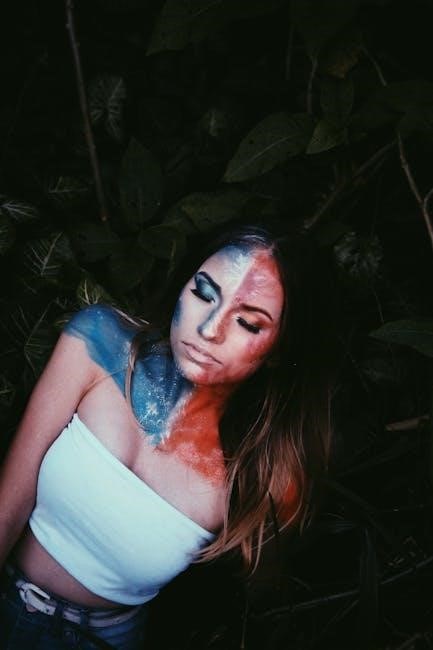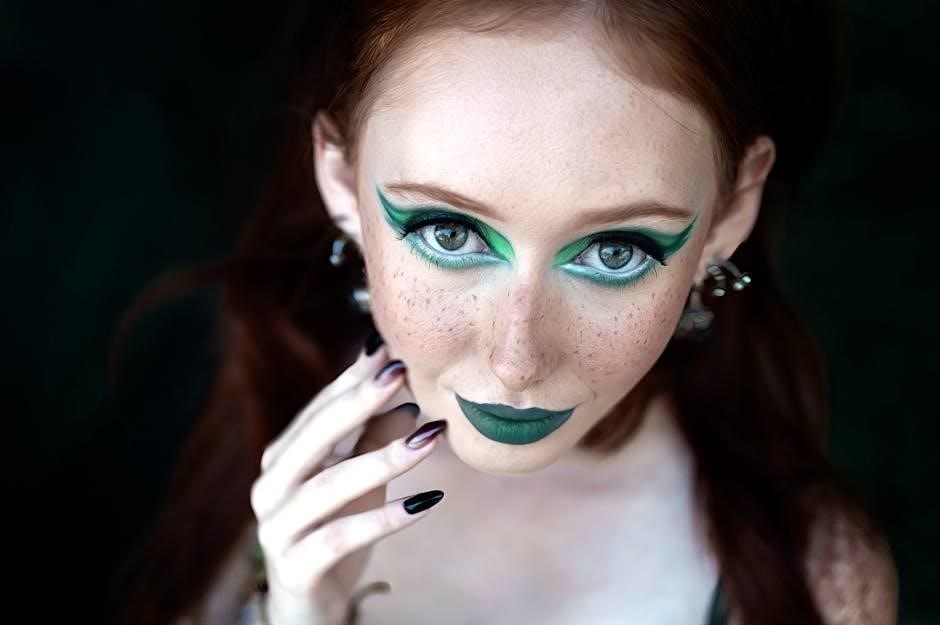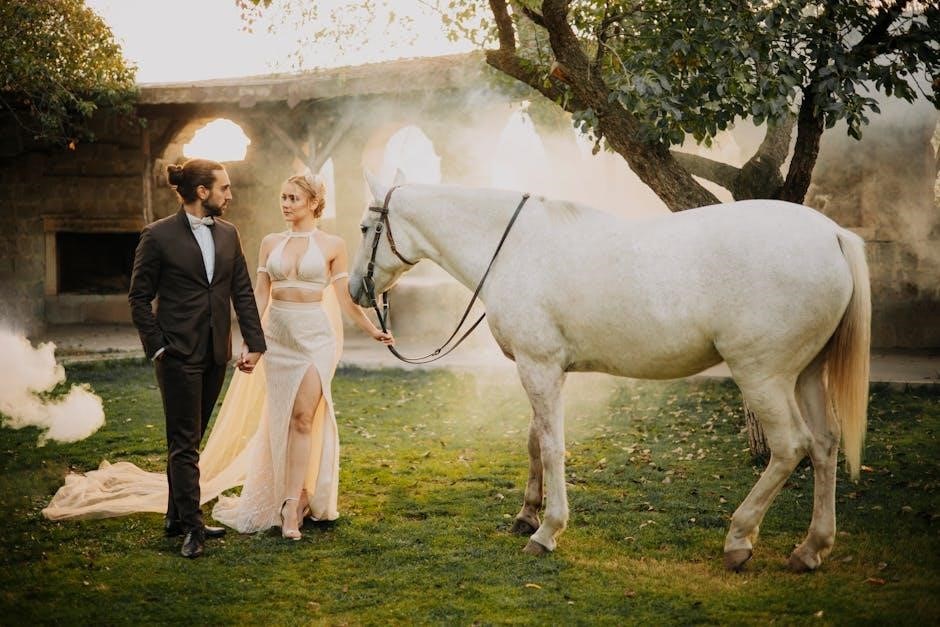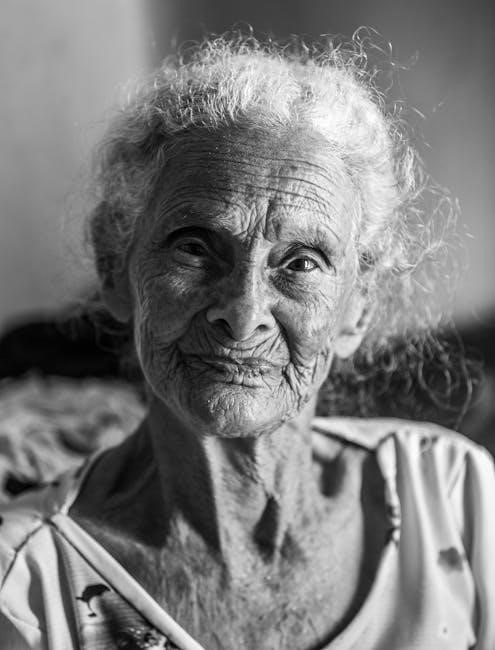The original story of Beauty and the Beast‚ written by Gabrielle-Suzanne Barbot de Villeneuve in 1740‚ is a timeless fairy tale exploring themes of inner beauty‚ transformation‚ and love; The narrative‚ first published in La Jeune Américaine et les Contes Marins‚ has become a cornerstone of world literature‚ inspiring countless adaptations. Its rich moral lessons and intricate characters continue to captivate readers globally.
1.1 Historical Context of the Tale
The original story of Beauty and the Beast was written by Gabrielle-Suzanne Barbot de Villeneuve in 1740‚ during the Enlightenment in France. It reflects the social and moral values of 18th-century Europe‚ emphasizing virtue‚ kindness‚ and the transformative power of love. The tale draws inspiration from earlier fairy tales and folklore‚ blending realism with fantasy. Villeneuve’s version‚ published in La Jeune Américaine et les Contes Marins‚ became a foundational work in fairy tale literature‚ shaping the narrative for future adaptations.
1.2 The Author: Gabrielle-Suzanne Barbot de Villeneuve
Gabrielle-Suzanne Barbot de Villeneuve was a French novelist and fairy tale writer‚ born in 1695. She is best known for her original version of Beauty and the Beast‚ published in 1740. Villeneuve’s work often explored themes of morality‚ love‚ and personal growth‚ reflecting the intellectual climate of the Enlightenment. Her contributions to literature remain significant‚ particularly in the realm of fairy tales‚ where her detailed narratives set a new standard for storytelling.
1.3 The Original Publication and Its Significance
The original story of Beauty and the Beast was first published in 1740 within Gabrielle-Suzanne Barbot de Villeneuve’s collection La Jeune Américaine et les Contes Marins. This publication marked a significant milestone in fairy tale literature‚ offering a detailed and morally rich narrative that captivated readers. Its release not only established Villeneuve as a prominent writer but also set a new standard for storytelling‚ blending intricate characters with timeless themes. The tale’s enduring popularity underscores its cultural and literary importance.

The Plot of the Original Beauty and the Beast
The merchant takes a rose for Beauty‚ leading to her sacrifice. She lives with the Beast in an enchanted castle‚ uncovering its secrets and transforming their fate through love.
2.1 The Merchant’s Journey and the Rose
The merchant’s journey begins with a quest for wealth‚ but a harsh storm forces him to seek shelter in the Beast’s castle. To appease the Beast‚ he plucks a rose‚ a seemingly innocent act that leads to dire consequences. This pivotal moment sets the story in motion‚ as the rose becomes a symbol of Beauty’s eventual sacrifice and the catalyst for the transformative events that follow.
2.2 Beauty’s Sacrifice and Life with the Beast
Beauty’s selfless decision to take her father’s place in the Beast’s castle highlights her courage and compassion. Initially‚ she faces fear and isolation‚ struggling to adjust to the enchanted environment. Despite the Beast’s intimidating presence‚ she begins to uncover the castle’s secrets‚ discovering magical objects that aid her. Her resilience and kindness gradually bridge the gap between her and the Beast‚ setting the stage for a profound connection that transcends physical appearances.
2.3 The Enchanted Castle and Its Secrets
The Beast’s castle is a marvel of magic‚ filled with enchanted objects and hidden wonders. Beauty discovers talking furniture‚ invisible servants‚ and a library that seems endless. The castle’s secrets‚ such as the mysterious rose and magical mirrors‚ reveal its ancient curse. As Beauty explores‚ she uncovers the castle’s true nature‚ which reflects the Beast’s inner turmoil. The castle becomes a character itself‚ symbolizing transformation and the power of love to break even the strongest spells.

Key Themes in the Original Story
The tale explores themes of inner beauty‚ transformation‚ and the triumph of love over adversity. It emphasizes kindness‚ sacrifice‚ and the power of true love to transform lives.
3.1 Beauty and Inner Virtue
Beauty’s character embodies inner virtue‚ showcasing her kindness‚ humility‚ and resilience. Unlike her siblings‚ she remains uncorrupted by material desires‚ demonstrating that true beauty lies within. Her selfless act of sacrificing her freedom for her father highlights her moral strength. The story emphasizes that inner beauty‚ not physical appearance‚ is the most valuable trait‚ making her a timeless role model for integrity and compassion.
3.2 The Beast as a Symbol of Transformation
The Beast represents a profound transformation from arrogance to humility. Cursed for his pride‚ he must learn to love selflessly to regain his humanity. His journey symbolizes personal growth and redemption‚ as he evolves from a fearsome creature to a compassionate prince. This transformation underscores the story’s theme of inner change and the power of love to overcome even the deepest flaws‚ making the Beast a powerful symbol of human potential for redemption and acceptance.
3.3 Love Conquering All Obstacles

Love is portrayed as a transcendent force in the original story‚ overcoming physical and emotional barriers. Despite the Beast’s intimidating appearance‚ Beauty’s unwavering compassion and kindness transform their relationship. Their bond grows through shared experiences‚ ultimately breaking the curse. This theme emphasizes that true love sees beyond superficiality‚ conquering fear‚ prejudice‚ and even enchantments. The tale illustrates how selfless love can redeem and transform‚ making it a universal and enduring message that resonates deeply with readers of all ages.
The Character of Beauty
Beauty is depicted as a kind‚ courageous‚ and selfless young woman whose inner strength and compassion drive the story. Her unwavering loyalty and grace shine through her hardships‚ making her a timeless symbol of virtue and resilience.
4.1 Beauty’s Personality and Strengths

Beauty is portrayed as a kind‚ courageous‚ and selfless young woman whose inner strength and resilience inspire those around her. Her compassion and grace shine through her willingness to sacrifice for her family‚ showcasing her unwavering loyalty. Beauty’s ability to see beyond the Beast’s physical appearance highlights her profound understanding of true beauty and kindness. These qualities make her a timeless symbol of virtue and strength‚ inspiring readers across generations.
4.2 Her Relationship with the Beast
Beauty’s relationship with the Beast evolves from initial fear and duty to deep affection and understanding. Despite his intimidating appearance‚ Beauty discovers the Beast’s vulnerable and kind nature‚ fostering a bond built on mutual respect. Her presence tames his inner ferocity‚ while his actions reveal a profound longing for connection. This transformation underscores the power of empathy and companionship‚ turning a captive situation into a meaningful partnership that transcends physical form.
4.3 Beauty as a Role Model in 18th-Century Literature
Beauty emerged as a pioneering female figure in 18th-century literature‚ embodying intelligence‚ courage‚ and selflessness. Her willingness to sacrifice for her family and her ability to see beyond the Beast’s appearance challenged traditional gender roles. Unlike many female characters of the era‚ Beauty’s agency and moral strength made her a progressive role model. Her story inspired future literary heroines‚ showcasing that true beauty lies in character rather than physical appearance‚ a message that resonated deeply with readers.
The Beast: A Complex Character
The Beast‚ a prince cursed for his arrogance‚ embodies both ferocity and vulnerability. His physical monstrousness contrasts with a deep inner suffering‚ revealing a multifaceted nature.
5.1 The Beast’s Physical and Emotional State
The Beast’s imposing physical form‚ with sharp claws and shaggy fur‚ hides a deeply emotional soul. His gruff exterior masks a profound loneliness and internal pain‚ shaped by the curse. Despite his fearsome appearance‚ he is capable of tenderness and introspection‚ yearning for connection and redemption. This duality makes him a compelling and sympathetic character‚ evoking both fear and pity in readers.
5.2 The Curse and Its Meaning
The curse transforming the prince into the Beast is a punishment for his arrogance and lack of compassion. It serves as a moral lesson‚ emphasizing the importance of inner beauty over physical appearance. The enchantress’s spell can only be broken by selfless love‚ highlighting the transformative power of kindness and humility. This central plot device drives the story’s themes of redemption and personal growth‚ making it a pivotal element in the tale’s enduring appeal.
5.3 The Beast’s Transformation and Redemption
The Beast’s transformation and redemption unfold through his evolving relationship with Beauty. Initially feared and reviled‚ he gradually reveals a deeper‚ kindness-driven nature. Beauty’s unwavering compassion and acceptance soften his heart‚ leading to his inner transformation. Ultimately‚ their mutual love breaks the curse‚ restoring him to his true form. This journey symbolizes the power of love and redemption‚ showcasing that true change comes from within‚ making the Beast’s character one of the most compelling in the tale.

The Cultural Impact of the Original Story
The original tale of Beauty and the Beast has inspired countless adaptations‚ including the 1991 Disney film‚ solidifying its place in global culture and literature.
6.1 Adaptations in Literature and Film
The original story of Beauty and the Beast has been adapted into numerous literary works‚ films‚ and stage productions. The 1991 Disney animated film remains a cultural phenomenon‚ while Jean Cocteau’s 1946 live-action adaptation brought the tale to life in a darker‚ more surreal manner. Additionally‚ the story has inspired Broadway musicals‚ such as Disney’s adaptation‚ further cementing its global influence. These adaptations highlight the timeless appeal of Villeneuve’s original narrative‚ ensuring its continued relevance across generations.
6.2 The 1991 Disney Adaptation
Disney’s 1991 animated Beauty and the Beast captivated audiences worldwide‚ blending enchanting music‚ memorable characters‚ and a charming narrative. The film simplifies Villeneuve’s original tale‚ focusing on Belle’s kindness and the Beast’s redemption. Iconic songs like “Be Our Guest” and “Beauty and the Beast” enhanced its magic. This adaptation remains a beloved classic‚ introducing the story to new generations while staying true to its core themes of love and transformation‚ solidifying its place in pop culture history.
6.3 Modern Interpretations and Relevance
Modern retellings of Beauty and the Beast continue to resonate‚ reflecting contemporary values like gender equality and diversity. Adaptations often emphasize Belle’s independence and the Beast’s humanity‚ appealing to today’s audiences. The tale’s universal themes of kindness‚ acceptance‚ and love transcend time‚ making it a timeless classic. Digital formats and new media ensure its accessibility‚ keeping Villeneuve’s original story relevant in the 21st century‚ inspiring fresh explorations of its enduring moral and emotional depth.
Accessing the Original Story in PDF Format
The original story of Beauty and the Beast by Gabrielle-Suzanne Barbot de Villeneuve is available as a free PDF‚ offering easy access to the timeless tale. Various editions and translations ensure accessibility for global readers.
7.1 Where to Find the Original PDF
The original PDF of Beauty and the Beast by Gabrielle-Suzanne Barbot de Villeneuve can be found on various online platforms. Websites like Google Books‚ ManyBooks‚ and Project Gutenberg offer free downloads of the 1756 edition. Additionally‚ platforms such as Amazon and eBook stores provide downloadable versions in PDF‚ ePub‚ and Kindle formats. No registration is required for many of these sources‚ making it easily accessible to readers worldwide.
7.2 Different Editions and Translations
The original tale of Beauty and the Beast is available in multiple editions and translations. The 1756 version remains the most authentic‚ while modern translations by Aurora Wolfgang offer fresh perspectives. Illustrated editions‚ such as those by Edward Corbould‚ enhance the story visually. Translations into languages like French and Spanish expand its global reach‚ ensuring the tale’s universality. These diverse editions cater to different audiences‚ preserving the story’s timeless appeal.
7.3 Reading the Story in Digital Format
The original story of Beauty and the Beast is widely available in digital formats‚ including PDF‚ epub‚ and Kindle. Readers can download the 1756 version or modern translations for free from various platforms. Digital editions offer convenience‚ allowing readers to access the tale anytime‚ anywhere. Illustrated and annotated versions enhance the reading experience‚ making it easier for audiences to engage with Villeneuve’s classic narrative in a contemporary format;

Literary Analysis of the Original Tale
Gabrielle-Suzanne Barbot de Villeneuve’s Beauty and the Beast explores themes of inner beauty‚ transformation‚ and moral growth. The story delves into the complexities of human nature‚ emphasizing kindness and selflessness. The Beast’s curse serves as a metaphor for redemption‚ highlighting the power of love to transcend physical appearance. This timeless tale offers profound insights into human emotions and societal values‚ making it a rich subject for literary exploration and analysis.
8.1 Feminist Perspectives on Beauty
Feminist interpretations of Beauty and the Beast highlight Beauty’s autonomy and strength; She defies traditional gender roles by prioritizing her family’s well-being over societal expectations. Her willingness to sacrifice herself for her father showcases her agency and courage. Villeneuve’s portrayal of Beauty as a kind‚ intelligent‚ and independent woman challenges patriarchal norms‚ emphasizing inner beauty over physical appearance. This feminist lens underscores Beauty’s role as a powerful symbol of female resilience and moral integrity in 18th-century literature.
8.2 The Role of Morality in the Story
Morality is a central theme in Beauty and the Beast‚ emphasizing virtues like kindness‚ humility‚ and selflessness; Beauty’s unwavering compassion and the Beast’s eventual redemption illustrate the transformative power of moral integrity. The story teaches that true beauty stems from inner goodness‚ while outward appearances can be deceiving. Villeneuve uses the narrative to convey moral lessons‚ encouraging readers to embrace empathy and understand that love and kindness can conquer even the deepest flaws and prejudices.
8.3 Symbolism and Hidden Meanings
The original story is rich in symbolism‚ with the Beast representing inner transformation and Beauty embodying selfless love. The enchanted castle symbolizes isolation and the journey to self-discovery‚ while the rose signifies the fleeting nature of beauty and the power of love. These elements weave a narrative that transcends surface-level storytelling‚ inviting readers to reflect on the deeper meanings of compassion‚ sacrifice‚ and the triumph of inner beauty over external appearances.

The Legacy of Gabrielle-Suzanne Barbot de Villeneuve
Gabrielle-Suzanne Barbot de Villeneuve’s legacy endures as a foundational figure in fairy tale literature‚ inspiring countless adaptations and influencing modern storytelling with her timeless themes.
9.1 Her Contributions to Fairy Tale Literature

Gabrielle-Suzanne Barbot de Villeneuve significantly enriched fairy tale literature with her detailed narratives and moral depth. Her work introduced complex characters and themes‚ setting a new standard for the genre. Through Beauty and the Beast‚ she explored inner beauty‚ transformation‚ and love‚ influencing future writers and adaptations; Her contributions remain foundational‚ shaping the evolution of fairy tales into modern storytelling.

9.2 The Evolution of Beauty and the Beast
Since its debut in 1740‚ Beauty and the Beast has evolved significantly through various adaptations. Villeneuve’s original tale‚ rich in detail and moral complexity‚ inspired Jeanne-Marie Leprince de Beaumont’s shorter version in 1756. Later‚ the 1991 Disney adaptation popularized the story globally‚ blending music and animation. Modern retellings continue to reinterpret the narrative‚ ensuring its timeless appeal and universal relevance across cultures and generations‚ while maintaining the core themes of transformation and unconditional love.
9.3 Her Influence on Modern Authors
Gabrielle-Suzanne Barbot de Villeneuve’s Beauty and the Beast has profoundly influenced modern authors and storytellers. Her exploration of inner beauty‚ transformation‚ and unconditional love continues to inspire writers‚ filmmakers‚ and artists. The story’s adaptability has led to numerous reinterpretations‚ from Disney’s beloved animation to contemporary literary reimaginations. Villeneuve’s legacy endures as her tale remains a timeless inspiration‚ shaping new narratives while preserving its original emotional and moral depth for fresh audiences worldwide.
The Original Story’s Place in World Literature
Beauty and the Beast is a cornerstone of world literature‚ influencing countless adaptations and inspiring new narratives. Its enduring popularity and universal themes have shaped fairy tale traditions‚ appealing to diverse cultures and generations. The story’s availability in PDF format has further cemented its global accessibility and relevance‚ ensuring its continued impact on readers worldwide.
10.1 Comparisons with Other Fairy Tales
Beauty and the Beast shares themes of transformation and redemption with tales like Cinderella and Sleeping Beauty‚ yet its depth and complexity set it apart. Unlike other stories where magic resolves conflicts‚ this tale focuses on psychological growth and moral lessons. The Beast’s journey from monster to prince mirrors universal human struggles‚ while Beauty’s courage and compassion redefine heroism. Its unique blend of realism and fantasy makes it a benchmark in fairy tale literature‚ influencing countless adaptations and inspiring new narratives.
10.2 The Story’s Universality and Timelessness
The tale of Beauty and the Beast transcends cultural and temporal boundaries‚ resonating with audiences across generations. Its exploration of love‚ sacrifice‚ and self-discovery speaks to universal human experiences. The story’s adaptability to various mediums‚ from literature to film‚ underscores its enduring relevance. Themes of inner beauty and transformation remain timeless‚ making it a cherished narrative in global literature‚ appealing to diverse audiences and ensuring its continued popularity in modern times.
10.3 Its Impact on Popular Culture
The original tale of Beauty and the Beast has left an indelible mark on popular culture‚ inspiring countless adaptations‚ including Disney’s 1991 animated classic and the 2017 live-action film. Its themes of love and transformation have influenced literature‚ film‚ and even Broadway musicals. The story’s iconic characters and moral lessons continue to captivate audiences‚ making it a timeless narrative that resonates across generations and mediums‚ ensuring its enduring relevance in modern entertainment and storytelling.
The original Beauty and the Beast story remains a timeless tale of love‚ transformation‚ and inner beauty‚ continuing to captivate readers and inspire adaptations across generations.
11.1 The Enduring Appeal of Beauty and the Beast
The tale’s enduring appeal lies in its universal themes of inner beauty‚ transformation‚ and love transcending appearances. Gabrielle-Suzanne Barbot de Villeneuve’s original story‚ with its rich moral lessons and intricate characters‚ continues to captivate readers and inspire adaptations. The story’s timeless relevance is evident in its ability to evolve across cultures and mediums‚ ensuring its place as a beloved classic in world literature.
11.2 The Importance of Reading the Original Story
Reading the original story of Beauty and the Beast by Gabrielle-Suzanne Barbot de Villeneuve offers a deeper understanding of its themes and characters. The 1756 version‚ available in PDF‚ provides insights into the tale’s historical context and moral lessons. It allows readers to appreciate the story’s complexity and the author’s intent‚ distinguishing it from later adaptations. Engaging with the original text enriches the reader’s connection to this foundational work in fairy tale literature.
11.3 Final Thoughts on the Tale’s Significance
Beauty and the Beast remains a profound tale‚ transcending time and culture. Its exploration of inner beauty‚ transformation‚ and unconditional love resonates universally. The original story‚ available in PDF‚ highlights Gabrielle-Suzanne Barbot de Villeneuve’s mastery in crafting a narrative that not only entertains but also imparts moral wisdom. Its enduring appeal lies in its ability to evoke reflection and inspire hope‚ solidifying its place as a cherished classic in world literature and popular culture.
